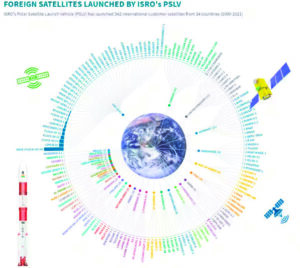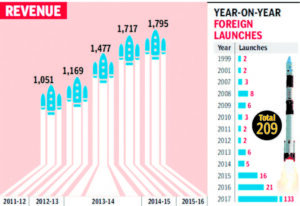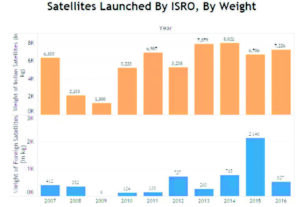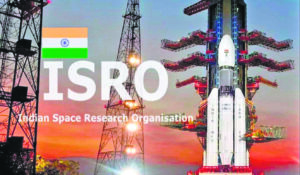The Indian Space Research Organisation is the national space agency of India. It operates as the primary research and development arm of the Department of Space (DoS), which is directly overseen by the Prime Minister of India while the Chairman of ISRO also acts as the executive of DoS. ISRO is primarily responsible for performing tasks related to space-based operations, space exploration, international space cooperation and the development of related technologies. ISRO is one of the six government space agencies in the world that possesses full launch capabilities, can deploy cryogenic engines, can launch extraterrestrial missions and operate a large fleet of artificial satellites. ISRO is one of the four government space agencies to have soft landing (uncrewed) capabilities.




India’s space agency, the Indian Space Research Organisation (ISRO), has achieved remarkable success in the last decade, particularly in launching foreign satellites and expanding its commercial space missions. According to information disclosed in the Rajya Sabha, the upper chamber of India’s Parliament, ISRO has launched 397 foreign satellites over the past ten years, generating an impressive revenue of USD 441 million.
ISRO’s commercial endeavours primarily involve the use of its Polar Satellite Launch Vehicle (PSLV), the most frequently used rocket in its fleet. Notably, the PSLV set a record by launching 104 satellites in a single mission in 2017. Additionally, ISRO has employed the Geosynchronous Satellite Launch Vehicle (GSLV) and the Small Satellite Launch Vehicle (SSLV) for specific commercial missions.
The SSLV, the newest addition to ISRO’s fleet, faced an initial setback during its maiden flight in August 2022. However, it successfully lifted off in February 2023, showcasing India’s capability to deploy diverse rockets for commercial purposes.
The information presented by Jitendra Singh, the Minister of State in the Prime Minister’s Office, highlighted India’s robust space capabilities and its role in the global space arena. The achievements include launching satellites for numerous countries, such as Australia, Austria, Belgium, Canada, Czech Republic, Finland, France, Germany, Israel, Italy, Japan, Latvia, Lithuania, Luxembourg, Republic of Korea, Singapore, Slovakia, Spain, Switzerland, Netherlands, UAE, United Kingdom, and the USA.
Moreover, Singh underscored the role of NewSpace India Limited (NSIL), the commercial arm of ISRO, in marketing Indian capabilities for launching foreign satellites. NSIL aims to advance the manufacturing of launch rockets, contributing to India’s self-reliance in the space sector. Singh also mentioned a collaborative effort between Hindustan Aeronautics Limited (HAL) and Larsen and Toubro (L&T) to build PSLV rockets, with a contract worth Rs 860 crore.
India’s space exploration journey has witnessed a paradigm shift in recent years, marked by increased political support, private investments, and revenue generated from international satellite launches. Minister Jitendra Singh emphasized the transformative impact of Prime Minister Narendra Modi’s tenure on India’s space endeavours, breaking self-imposed restrictions and achieving significant milestones.
Private sector involvement has been a key driver of India’s space sector growth, with the number of space startups surging from one in 2019 to over 190 at present. These startups have attracted private investments exceeding Rs 1,000 crores, reflecting a burgeoning interest in space-related ventures. Singh drew parallels with NASA, highlighting that private companies contribute significantly to NASA’s resources, showcasing India’s progress in private space launches.
In October last year and in March this year, it used the largest and most capable LVM3 rocket to launch commercial missions. It launched a total of 72 satellites into orbit. These are satellites from OneWeb (now Eutelsat OneWeb).
“In 2019, there was only one space startup, and now it has grown to 190. More than Rs 1,000 crores have been invested in the space industry. We used to confine ourselves with self-imposed restrictions, comparing ourselves to NASA. But we forget that half of NASA’s resources come from private companies. Today, American and Russian satellites are being launched from our end,” said Minister Jitendra Singh. Singh emphasized the wide-ranging impact of space technology on everyday life, touching on various sectors such as digital health, ownership programs, rocket launching, and infrastructure development. He highlighted the omnipresence of space technology, emphasizing its role in shaping modern life.
According to Singh, ISRO’s achievements include launching approximately 430 foreign satellites for various countries, contributing significantly to the global space community. The revenue generated from these satellite launches amounts to roughly 290 million euros (Rs 2,635 crores) from European satellites and over $170 million (Rs 1,417 crores) from American satellites.
India’s space exploration efforts, led by ISRO, have witnessed unprecedented success in the past decade. The country has emerged as a reliable partner for international satellite launches, generating substantial revenue and attracting private investments. The collaborative efforts between the government and the private sector, along with the advancements in rocket technology, reflect India’s commitment to space exploration and self-reliance in the space sector.
Forthcoming missions
Minister Jitendra Singh provided insights into upcoming space missions, revealing that the delayed Gaganyaan mission is scheduled to launch a humanoid robot into space in early 2025. Subsequently, India anticipates sending its first astronaut into space by mid-2025, marking a significant milestone in its space exploration endeavors.
Looking ahead, Singh detailed the expansive lunar exploration mission ‘Chandrayaan’ and the ambitious ‘Deep Sea Mission’ slated for 2047. These missions underscore India’s commitment to exploring both outer space and the vast potential of its oceans, which have largely remained untapped.
Singh underscored the significance of India’s maritime economy, outlining plans to extract minerals from the Indian Ocean through missions like Himalaya and Samudrayaan. These initiatives aim to unlock the immense economic potential of the ocean, projecting a staggering growth of $100 billion by 2040.
In summary, India’s space ambitions extend to human spaceflight, lunar exploration, and comprehensive oceanic missions, reflecting a holistic approach to tapping into the vast resources of both space and the sea for economic and scientific advancements.














